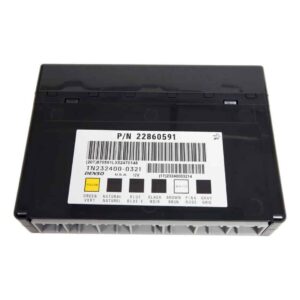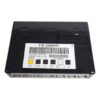Restore Full Electrical Control to Your Pontiac G8
Is your 2008-2009 Pontiac G8 acting possessed? Flickering lights, malfunctioning power windows or locks, and strange warning messages on the dash are more than just an annoyance—they’re classic signs of a failing Body Control Module (BCM). The BCM is the central nervous system for your vehicle’s body electronics, and when it starts to go, it can cause a cascade of frustrating and unpredictable problems. Don’t let a faulty module sideline your performance sedan. This fully programmed BCM is the reliable, straightforward solution to get your G8 back to perfect working order.
We take the guesswork and dealer hassle out of the equation. Unlike a generic part from a salvage yard, this BCM is programmed specifically to your vehicle’s VIN before it ships. This means we load the latest GM software and configure it to match your car’s exact options. This critical step ensures seamless integration and prevents the compatibility issues that plague unprogrammed modules. Simply provide your VIN at checkout, and we handle the complex part for you.
From the Diagnostic Bay: The BCM vs. Bad Grounds
I once had a 2008 G8 in the shop with a laundry list of electrical gremlins—the radio would cut out, the interior lights would pulse, and the driver’s window worked only when it wanted to. The owner had already replaced the alternator and battery, suspecting a power supply issue. After confirming the charging system was fine, I went straight to the BCM data stream. I noticed erratic voltage readings on several circuits controlled by the module. While a bad ground can cause similar issues, a quick check of the main grounding points under the dash showed they were clean and tight. The true culprit was internal failure within the BCM, causing it to misinterpret signals and send faulty commands. A new, programmed BCM solved every single issue instantly. Always check your grounds, but don’t overlook the module itself when multiple, unrelated electrical systems act up.
Common Signs of a Failing BCM
A failing Body Control Module can manifest in numerous ways. If you’re experiencing any of the following, your BCM is the likely suspect:
- ✔ Erratic or non-functional power windows, door locks, or mirrors.
- ✔ Interior or exterior lights that stay on, flicker, or won’t turn on at all.
- ✔ The security system acting up, causing a no-start condition (anti-theft light flashing).
- ✔ Intermittent operation of the horn, windshield wipers, or radio.
- ✔ False warnings on the instrument cluster (e.g., ‘Door Ajar’ when all doors are closed).
- ✔ Diagnostic Trouble Codes (DTCs) such as U0140, U0155, or other ‘U’ (network) codes pointing to a loss of communication.
A Straightforward Guide to Installation
Installing your new 2008-2009 G8 Body Control Module is a manageable task for a confident DIYer. For the G8, the BCM is typically located in the center dash area. Always consult a service manual for the exact location and procedure for your specific vehicle.
- Safety First: Disconnect the negative terminal from your vehicle’s battery and wait at least 10 minutes to allow all systems to power down completely.
- Access the Module: Carefully remove the necessary dash panels to gain access to the old BCM. This may involve removing trim pieces around the center console or glove box.
- Disconnect and Remove: Unplug the electrical connectors from the old BCM. They have locking tabs that must be depressed to be released. Once disconnected, unbolt or unclip the module from its mounting bracket.
- Install the New BCM: Mount your new, pre-programmed BCM in the same location and reconnect all electrical connectors. Ensure they click securely into place.
- Reconnect and Test: Reassemble the dash panels, reconnect the negative battery terminal, and start the vehicle. Test all body functions—lights, locks, windows, wipers, etc.—to confirm the repair.
- Perform Relearns (If Needed): In some cases, you may need to perform additional procedures. If your airbag light is on, an ‘SDM Key Relearn’ is required. A ‘Brake Pedal Position Relearn’ may also be necessary. These procedures often require a professional scan tool.
Verified Vehicle Compatibility
This Body Control Module, part number 20935349, is a direct replacement for a wide range of General Motors vehicles. While this listing is focused on the 2008-2009 G8 Body Control Module, it also fits many other models. It is a compatible replacement for the following part numbers: 10382479, 15093910, 15276271, 15299986, 15819552, 20921435, 22860591, and many more. Key compatible models include:
- ✔ 2008-2009 Pontiac G8 (Center Dash)
- ✔ 2007-2012 GMC Acadia (LH Dash)
- ✔ 2011-2013 Chevrolet Caprice
- ✔ 2008-2013 Cadillac CTS (LH Dash)
- ✔ 2006-2013 Chevrolet Impala (LH Dash)
- ✔ 2008-2012 Chevrolet Express / GMC Savana Vans
- ✔ 2010 Cadillac Escalade, Chevrolet Tahoe/Suburban, GMC Yukon (ID Specific)
- …and many other GM cars, trucks, and SUVs. Please verify your part number to ensure compatibility.
Frequently Asked Questions
Do I need to do any programming myself?
No. We handle all the programming for you before shipping. Just provide your vehicle’s 17-digit VIN during or after checkout, and the module will arrive ready to install.
Is there a core charge for my old BCM?
Absolutely not. There is no core charge on this part. You can keep your original module without any extra fees or hassle.
What if my airbag light is on after installation?
This can happen occasionally. It means the new BCM needs to be synced with the airbag system’s SDM (Sensing and Diagnostic Module). A procedure called ‘Setup SDM Primary Key in BCM’ will need to be performed with a professional-grade diagnostic tool to resolve this.
What is the Brake Pedal Position Relearn?
On some models, the BCM needs to recalibrate the position of the brake pedal sensor. This is essential for proper brake light and traction control operation. This may also require a scan tool.
How do I find my original BCM part number?
The part number is printed on a sticker directly on the module’s housing. You will need to access the module in your vehicle to read it. Comparing it to our list of compatible numbers is the best way to confirm fitment.


